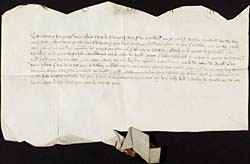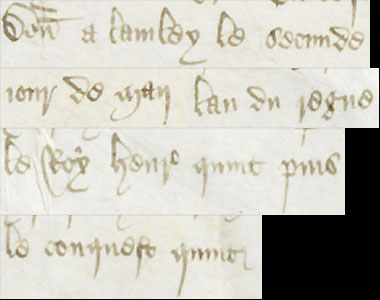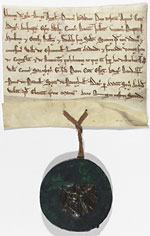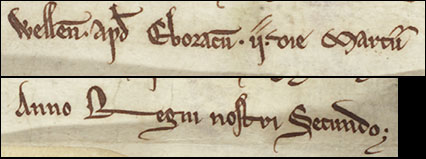even to the present day, it has been common practice to date some documents not according to the running number of the year, but according to the year of the presiding monarch. The regnal year is normally calculated from the date of the accession of a particular monarch, with the number changing on the anniversary of the accession. In order to interpret such dates, therefore, the user must know the date on which a monarch acceded to the throne. There are resources available to assist with this - in particular, Cheyney's Handbook of Dates. For details, see the list of further reading.
As an example, Henry V acceded to the throne on 21 March 1413. This means that his first regnal year (written 1 Henry V) began on 21 March 1413 and ended on 20 March 1414.
To illustrate the point in context, the deed provided here dates from the reign of Henry V. It is an agreement, written in French, between Lady Joan de Cromwell and Ralph de Cromwell. The date on the document ('le secunde jour de maii l'an du regne le Roy Henri quint puis le conqueste quinti') translates as the 2nd May, 5 Henry V. This means that the agreement is dated 2nd May 1417.

Agreement, 1417 (Ne D 742) with detail below

Users beware!
The regnal years of some monarchs present particular difficulties. For example, King John's regnal year was reckoned as beginning on the date of his coronation, not his accession. Unfortunately, this was on Ascension Day - a moveable feast which falls on a different date each year. This meant that his regnal years always began on a different date. Furthermore, sometimes they could be more than a year long and sometimes they could be less.
This grant by King John was made during a regnal year which lasted less than a full calendar year. The grant was made on the 2nd of March in the second year of John's reign, which began on the 18th of May 1200 and ended on the 2nd of May 1201. As a result, the document is dated 2nd of March 1201.

Grant, 1201 (Mi D 4650) with detail below

Another difficulty is that because a regnal year is normally calculated from a fixed date to a fixed date, the moveable feasts of the church - such as Easter - can sometimes take place twice in one year.
No comments:
Post a Comment